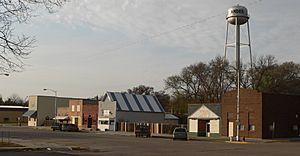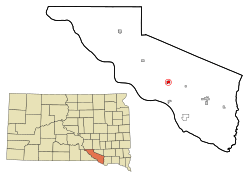Lake Andes, South Dakota facts for kids
Quick facts for kids
Lake Andes, South Dakota
|
|
|---|---|

Main Street, looking northwest, November 2011
|
|

Location in Charles Mix County and the state of South Dakota
|
|
| Country | United States |
| State | South Dakota |
| County | Charles Mix |
| Incorporated | 1905 |
| Area | |
| • Total | 0.77 sq mi (1.99 km2) |
| • Land | 0.75 sq mi (1.93 km2) |
| • Water | 0.02 sq mi (0.06 km2) |
| Elevation | 1,457 ft (444 m) |
| Population
(2020)
|
|
| • Total | 710 |
| • Density | 951.74/sq mi (367.44/km2) |
| Time zone | UTC-6 (Central (CST)) |
| • Summer (DST) | UTC-5 (CDT) |
| ZIP code |
57356
|
| Area code(s) | 605 |
| FIPS code | 46-35100 |
| GNIS feature ID | 1267448 |
Lake Andes is a city in, and the county seat of, Charles Mix County, South Dakota, United States. The population was 710 at the 2020 census.
The town took its name from Lake Andes which some say derives its name from a pioneer hunter named Handy, while others believe was named after Edward Andes, a fur company official. The town and the lake are referred to as Bde Ihaƞke in Dakota language of the native Yankton Sioux Tribe.
YST Transit serves the community and connects riders to Marty, Ravinia and Wagner as well.
Contents
Geography
Lake Andes is located within the Yankton Sioux Tribe's reservation.
According to the United States Census Bureau, the city has a total area of 0.82 square miles (2.12 km2), of which 0.80 square miles (2.07 km2) is land and 0.02 square miles (0.05 km2) is water.
Demographics
| Historical population | |||
|---|---|---|---|
| Census | Pop. | %± | |
| 1910 | 920 | — | |
| 1920 | 867 | −5.8% | |
| 1930 | 1,052 | 21.3% | |
| 1940 | 785 | −25.4% | |
| 1950 | 1,851 | 135.8% | |
| 1960 | 1,097 | −40.7% | |
| 1970 | 948 | −13.6% | |
| 1980 | 1,029 | 8.5% | |
| 1990 | 846 | −17.8% | |
| 2000 | 819 | −3.2% | |
| 2010 | 879 | 7.3% | |
| 2020 | 710 | −19.2% | |
| U.S. Decennial Census | |||
2010 census
As of the census of 2010, there were 879 people, 316 households, and 195 families residing in the city. The population density was 1,098.8 inhabitants per square mile (424.2/km2). There were 361 housing units at an average density of 451.3 per square mile (174.2/km2). The racial makeup of the city was 40.8% White, 0.1% African American, 52.7% Native American, 0.1% Asian, 0.1% from other races, and 6.1% from two or more races. Hispanic or Latino of any race were 2.8% of the population.
There were 316 households, of which 40.2% had children under the age of 18 living with them, 28.2% were married couples living together, 26.6% had a female householder with no husband present, 7.0% had a male householder with no wife present, and 38.3% were non-families. 34.8% of all households were made up of individuals, and 19.6% had someone living alone who was 65 years of age or older. The average household size was 2.52 and the average family size was 3.24.
The median age in the city was 33.8 years. 32.1% of residents were under the age of 18; 7.7% were between the ages of 18 and 24; 21.6% were from 25 to 44; 19.9% were from 45 to 64; and 18.7% were 65 years of age or older. The gender makeup of the city was 47.9% male and 52.1% female.
Community events
Fish Days takes place annually the first weekend in June. The Fort Randall traditional pow wow takes place annually the first weekend in August at the pow wow grounds.
Architecture
The Charles Mix County courthouse, located in Lake Andes, is a prominent fixture in the community. Constructed in the Prairie School architectural style, it was added to the National Register of Historic Places in 1993 as a significant example of architecture and local government.
On February 21, 2012, the 1910 Engel Hotel was listed on the NRHP. It is located at 202 Main Street and was built for the railroad industry.
Gallery
Notable people
- Faith Spotted Eagle, Native American activist
- John C. Miller Jr., Brigadier general in the United States Marine Corps and veteran of World War II.
See also
 In Spanish: Lake Andes (Dakota del Sur) para niños
In Spanish: Lake Andes (Dakota del Sur) para niños






